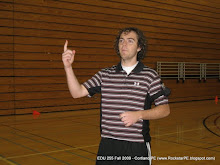Standard 1: Scientific and Theoretical Knowledge
Physical education teacher candidates know and apply discipline-specific scientific and theoretical concepts critical to the development of physically educated individuals.
Understanding and knowing how the body moves and works is vital for a Physical Educator. I have completed Anatomy 1 and 2, Motor Behavior, Biomechanics, and will be taking Exercise Physiology in the Spring 2010 semester. These classes have introduced me to important topics like how the body moves and various factors that contribute to movement of the body. Having an understanding in these topics will suit me students as I will be better able to explain how to perform proper movements.
Standard 2: Skill-Based and Fitness-Based Competence
Physical education teacher candidates are physically educated individuals with the knowledge and skills necessary to demonstrate competent movement performance and health-enhancing fitness as delineated in NASPE's K-12 Standards
As I continue my way through my Undergraduate work in Physical Education I continue to do well in activity classes. I feel that it is important to know various topics and be able to explain and demonstrate them for students. For example track and field, gymnastics, and racket activates are some of the activity courses I have completed. These and the rest of my activity classes will help me know how to teach to my students. In addition completion of Health Related fitness has helped me learn how to develop a proper workout based on results of different fitness tests.
Standard 3: Planning and Implementation.
Physical education teacher candidates plan and implement developmentally appropriate learning experiences aligned with local, state and national standards to address the diverse needs of all students.
During the Spring 2010 semester I will be taking Adaptive Physical Education class. I will learn more about working with students with disabilities. I have also had experience working with Cortland Homer After school Mentoring Program also know as CHAMP a program designed to help elementary children with home work but also improving physical and social aspects as well. While teaching in some of my other classes I have at times had to adapt my lesson on to meet the needs for my peers who were role playing students with diverse needs. Physical education is unique and can be taught differently to many people. As a teacher you cannot be set on doing things one way, but rather flexible.
Standard 4: Instructional Delivery and Management. Physical education teacher candidates use effective communication and pedagogical skills and strategies to enhance student engagement and learning.
To help enhance student engagement a teacher should show enthusiasm and use language that is appropriate to the students they are teaching. If the students do not understand what you are saying or can tell you are not excited to be there then they will not be excited and thus learning will be nearly impossible and not take place. Visual aids, like the one I used in my bowling lesson (view below), are important. Proper visual aids will help draw the attention of the learners and help give them valuable information that they can quickly look at to help them remember.
Standard 5: Impact on Student Learning.
Physical education teacher candidates utilize assessments and reflection to foster student learning and to inform instructional decisions.
Proper assessments are vital when determining ability or knowledge of the students. In my Stats 434 class we spent a great deal of time on validity, reliability, and authenticity of a proper assessment. We spent the second half of the year on a group project where we team-taught a lesson. We had to create a lesson and create an assessment both physical and cognitive. This helped me learn to differentiate qualities between a proper assessment versus an ineffective assessment.
Standard 6: Professionalism.
Physical Education teacher candidates demonstrate dispositions essential to becoming effective professionals.
An important aspect of a teacher is appearance such as how you dress and the manner in which you speak. I am always dressed in appropriate attire for my classes and when I teach. I am also prepared when I teach and will often be thinking of what I plan to say or how to adapt when things are not going as planned. In addition it is important to think of ways to improve lessons to better suit the students.
I feel that I meet each of these standards and know I will continue to improve at each during my undergraduate work. It is important to never be content with what you know or can do. There is always room for improvement and I know I will keep pushing myself to become a better teacher. Teaching Physical Education is what I love to do and I want change the way people view Phys Ed class and help as many as I can in doing so.
































